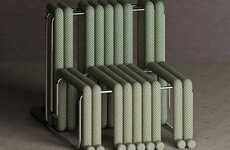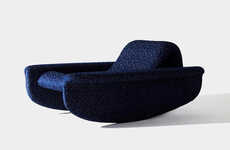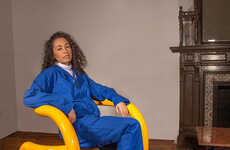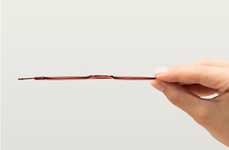
The Loom Chair is Rendered Sittable Thanks to a Woven Cord
Amelia Roblin — February 19, 2013 — Art & Design
References: cargocollective & blog.leibal
The basic structure of the Loom Chair is quite simply a frame of wooden dowels. The seat and the backrest are merely suggested by the timber composition before the defining secondary material is incorporated.
For each handmade model of the lounger, designer Laura Carwardine takes a single lengthy segment of rope and ties it to a back corner. She proceeds to wind, loop and coil it around four different horizontal rods in a crisscrossing form, gradually entwining a springing stringed seat. Mimicking the cloth-making technique of an old weaving apparatus on an enlarged scale, the Loom Chair is rendered even sturdier by the cord and provides a comfortable place to sit with a bit of flexibility behind its charming crafty appearance.
For each handmade model of the lounger, designer Laura Carwardine takes a single lengthy segment of rope and ties it to a back corner. She proceeds to wind, loop and coil it around four different horizontal rods in a crisscrossing form, gradually entwining a springing stringed seat. Mimicking the cloth-making technique of an old weaving apparatus on an enlarged scale, the Loom Chair is rendered even sturdier by the cord and provides a comfortable place to sit with a bit of flexibility behind its charming crafty appearance.
Trend Themes
1. Cord-wrapped Furniture - The trend of incorporating cord into furniture frames to create a unique, crafty appearance and added sturdiness provides an opportunity for disruptive innovation in sustainable, eco-friendly materials.
2. Handmade Minimalism - The trend of using simple structures as the base of furniture and adding handmade details elevates the piece and offers an opportunity for disruptive innovation in customizable designs.
3. Weaving Techniques in Furniture - The trend of incorporating weaving techniques into furniture design offers an opportunity for disruptive innovation in enhancing functionality and durability with unique materials.
Industry Implications
1. Furniture Design - The furniture design industry can benefit from disruptive innovation opportunities in incorporating eco-friendly and sustainable materials in cord-wrapped, handmade designs.
2. Craft and Decor Industry - The craft and decor industry can benefit from the trend of incorporating weaving techniques into furniture by developing new, unique designs and offering customization options for consumers.
3. Textile Industry - The textile industry can benefit from the trend of incorporating cord and weaving techniques into furniture by exploring new materials and developing innovative ways to incorporate them into furniture design.
5.5
Score
Popularity
Activity
Freshness























